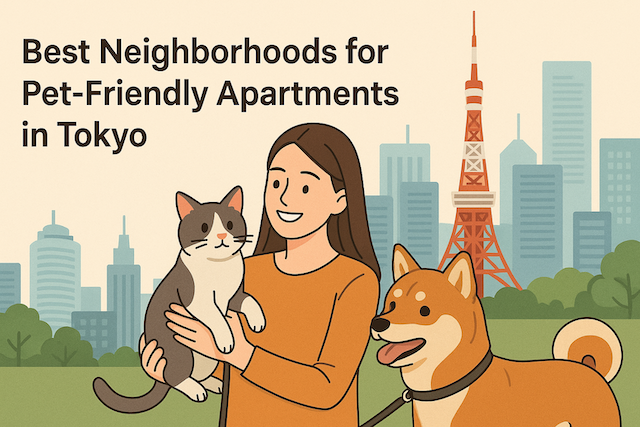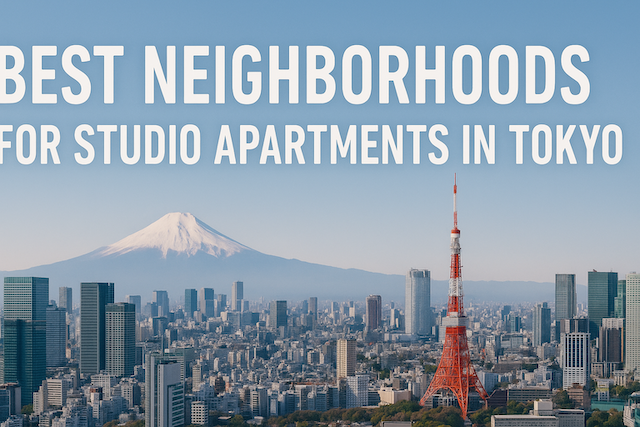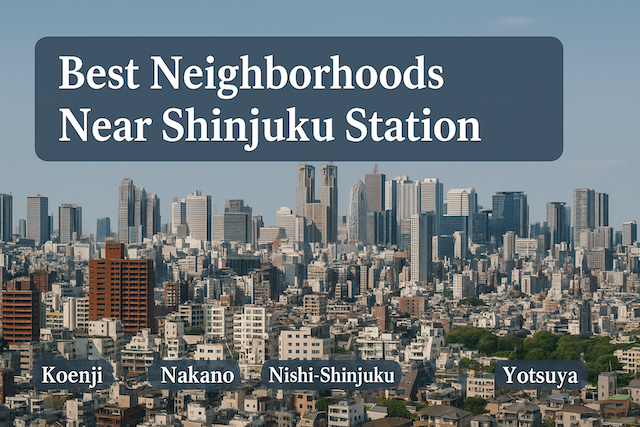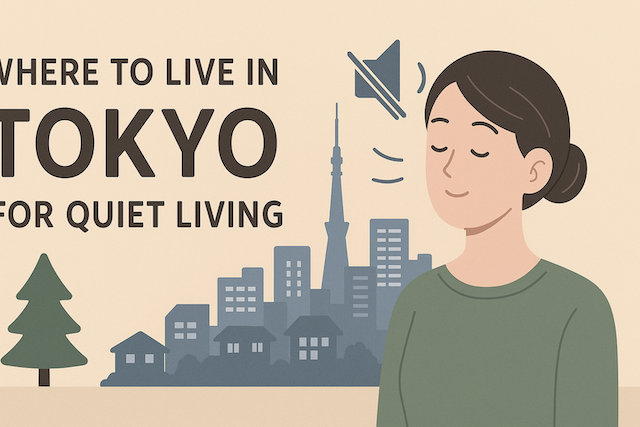Best Neighborhoods for Pet-Friendly Apartments in Tokyo
Tokyo is a bustling city known for its skyscrapers, world-class transportation, and compact living spaces—but for pet owners, finding a suitable apartment can be challenging. While not every landlord or building allows pets, there are several neighborhoods that stand out for being pet-friendly, offering green parks, accessible veterinarians, pet cafes, and modern apartment complexes that welcome furry companions.
This guide explores the best neighborhoods in Tokyo for pet-friendly apartments, outlining what makes each area ideal for pet owners, including access to pet care services, walking routes, and community vibes.
Hiroo – International and Pet-Friendly Luxury
Hiroo, located between Roppongi and Ebisu, is one of Tokyo’s most international and pet-welcoming neighborhoods. This area offers a refined and calm atmosphere, perfect for residents who enjoy a slower pace of life while staying close to central Tokyo.
Why Hiroo is Great for Pet Owners
-
Pet-Friendly Apartments: Many luxury buildings in Hiroo, especially along Hiroo Street and near Arisugawa Park, are designed to accommodate pets.
-
Green Spaces: Arisugawa-no-miya Memorial Park provides a lush, serene area for dog walking and morning strolls.
-
Pet Services: The neighborhood features multiple veterinary clinics, pet grooming salons, and specialized pet stores.
-
Community: Expatriates and locals alike often socialize through pet-centered activities, creating a welcoming environment.
Lifestyle Summary
Hiroo offers spacious apartments by Tokyo standards and easy access to international supermarkets and embassies. It’s ideal for professionals and families with pets who appreciate a quiet yet sophisticated area.
Ebisu – Urban Convenience with Pet-Friendly Living
Ebisu, adjacent to Hiroo and Daikanyama, strikes the perfect balance between urban life and pet-friendly comfort. Known for its stylish dining and proximity to parks, Ebisu is a popular choice among pet-owning professionals.
Highlights for Pet Owners
-
Apartments with Pet Options: Many modern towers and serviced apartments allow pets, with specific pet-friendly floors or dedicated walking areas.
-
Proximity to Green Spaces: Ebisu Garden Place has open areas suitable for quick walks, and Yebisu Park is nearby for more leisurely outings.
-
Convenience: With JR Yamanote Line and Hibiya Line access, pet owners can easily reach pet-friendly cafes in neighboring Daikanyama or Shibuya.
-
Pet Cafes & Groomers: Ebisu has trendy cafes that allow pets indoors or on terraces, making it easy to socialize with other pet owners.
Lifestyle Summary
Ebisu provides the sophistication of central Tokyo with convenient access to pet services and small parks. It’s ideal for single professionals or couples who want an elegant, pet-welcoming neighborhood.
Daikanyama – Trendy and Pet-Centric
Daikanyama, often called “Tokyo’s Little Brooklyn,” is one of the trendiest neighborhoods for both people and pets. With its chic cafes, tree-lined streets, and stylish apartment buildings, Daikanyama has become synonymous with relaxed, pet-friendly urban living.
Why Daikanyama Stands Out
-
Pet-Friendly Apartments: Many designer apartment complexes in Daikanyama are pet-approved, some even featuring pet washing stations or terraces.
-
Walkability: The neighborhood’s calm, low-rise streets are perfect for dog walking.
-
Pet-Friendly Shops: The popular Daikanyama T-Site complex welcomes pets and features pet boutiques and outdoor seating areas.
-
Nearby Parks: Saigoyama Park and Sugekari Park are within walking distance for green space access.
Lifestyle Summary
Daikanyama is the go-to spot for pet owners who want a fashionable, community-oriented lifestyle. Expect higher rent prices, but also unmatched convenience and style.
Nakameguro – Riverside Walks for You and Your Pet
Nakameguro, famous for its cherry blossom-lined Meguro River, is a paradise for pet owners who love scenic walks. It combines trendy cafés with a relaxed residential atmosphere.
What Makes Nakameguro Great for Pet Owners
-
Riverside Walks: The Meguro River promenade offers a long, picturesque path perfect for daily pet walks.
-
Pet-Friendly Residences: Many new condominiums and renovated apartments advertise pet allowances.
-
Pet Services: There are plenty of pet salons, clinics, and stores, especially around Nakameguro Station.
-
Community Feel: Pet owners often meet during walks, giving the area a warm, friendly neighborhood vibe.
Lifestyle Summary
Nakameguro is excellent for young professionals and couples who enjoy fashionable yet relaxed riverside living. The mix of green space and pet-friendly amenities makes it highly desirable.
Kichijoji – Green, Spacious, and Pet-Loving
Kichijoji consistently ranks among Tokyo’s most livable neighborhoods—and for good reason. Located on the Chuo Line, it offers an excellent mix of nature, shopping, and cultural vibrancy.
Why Kichijoji is Ideal for Pet Owners
-
Access to Nature: Inokashira Park is one of Tokyo’s largest and most beloved parks, with vast walking paths and open lawns.
-
Pet-Friendly Apartments: Many apartments in the Kichijoji and Inokashira areas allow pets, catering to families with dogs or cats.
-
Pet Services: The area has pet clinics, pet hotels, and large pet supply stores.
-
Relaxed Atmosphere: Despite its popularity, Kichijoji maintains a suburban calm ideal for raising pets.
Lifestyle Summary
Kichijoji is great for families or pet owners who prioritize green space and community life while still being connected to central Tokyo in under 30 minutes.
Setagaya – Suburban Comfort for Pet Families
Setagaya is Tokyo’s largest ward and one of its greenest residential areas, making it a natural favorite among pet owners. From quiet streets to spacious parks, Setagaya is known for family-oriented, pet-friendly housing.
Why Setagaya Appeals to Pet Owners
-
Wide Apartment Selection: Many low-rise apartments and single-family homes welcome pets.
-
Parks and Trails: Komazawa Olympic Park, a pet hotspot, features a large dog run and multiple trails.
-
Community Services: Setagaya’s pet clinics, training centers, and groomers are among the most numerous in Tokyo.
-
Transportation Access: With multiple train lines (Den-en-toshi, Odakyu, Tokyu), commuting to the city center is simple.
Lifestyle Summary
Setagaya is perfect for families with larger pets who need more space and outdoor access. It combines suburban tranquility with Tokyo’s connectivity.
Meguro – Central Yet Relaxed
Meguro is a charming, centrally located neighborhood offering both convenience and comfort. With easy access to Shibuya, Shinagawa, and Ebisu, it’s an ideal compromise for pet owners who want central living without sacrificing green spaces.
Benefits for Pet Owners
-
Pet-Friendly Apartments: Many luxury condos near Meguro Station accept pets and feature modern facilities.
-
Walkability: Quiet residential streets and the Meguro River offer scenic walking routes.
-
Proximity to Pet Services: Multiple pet hospitals, grooming salons, and pet-friendly cafes operate in the area.
Lifestyle Summary
Meguro offers a sophisticated, calm urban environment suitable for professionals or couples who want a blend of access and serenity.
Yoyogi-Uehara – Quiet, Upscale, and Green
Yoyogi-Uehara is a peaceful neighborhood in Shibuya Ward that attracts both Japanese and expat residents. It’s upscale, quiet, and surrounded by nature—ideal for pet owners seeking a calm home life.
Pet-Friendly Features
-
Proximity to Parks: Yoyogi Park and Komaba Park are both nearby, offering extensive walking areas.
-
High-End Apartments: Many luxury units around Yoyogi-Uehara Station are built with pet-friendly designs.
-
Community: The neighborhood has a small-town charm with cafes and shops that welcome pets.
Lifestyle Summary
Yoyogi-Uehara is suited for professionals or small families seeking peaceful living with green access and convenience to central Tokyo.
Azabu-Juban – Upscale Urban Living with Pet Comfort
Azabu-Juban combines modern luxury with tradition, offering an elegant living environment for pet owners. With its international schools and embassies, it’s a top choice for expats with pets.
Why Azabu-Juban Works for Pet Owners
-
Luxury Apartments: Many high-end buildings cater to pet owners, offering pet washing areas and dedicated play zones.
-
Nearby Parks: Arisugawa Park and Shiba Park are within walking distance.
-
Pet-Oriented Amenities: The area includes pet boutiques, international pet food stores, and veterinary services in English.
Lifestyle Summary
Azabu-Juban is one of the best neighborhoods for affluent pet owners who want sophistication, safety, and world-class amenities.
Odaiba – Seaside Freedom for Pets
For pet owners who love open spaces, Odaiba is unmatched. Located along Tokyo Bay, this futuristic district offers some of the most pet-friendly environments in the city.
Why Odaiba is Perfect for Pets
-
Open Spaces: Odaiba Seaside Park and Symbol Promenade Park offer vast walking areas.
-
Pet-Friendly Malls: Decks Tokyo Beach and VenusFort (and its successor area) have shops and restaurants that welcome pets.
-
Modern Apartments: Many condominiums in Odaiba are pet-approved, often with access to waterfront promenades.
Lifestyle Summary
Odaiba suits pet owners who prioritize outdoor freedom and waterfront living, ideal for medium to large dogs.
Tips for Renting a Pet-Friendly Apartment in Tokyo
1. Check “Pet Negotiable” Listings
Not all pet-friendly listings are clearly marked. Look for the term 「ペット相談可」(petto soudan ka)—meaning “pets negotiable”—in Japanese listings.
2. Expect Additional Fees
Pet-friendly apartments often require higher security deposits or a special cleaning fee upon move-out.
3. Clarify Restrictions
Some apartments only allow small dogs or cats, while others may have limits on the number or breed of pets.
4. Explore Nearby Parks
When choosing your area, proximity to green spaces or riversides can make daily walks much easier.
5. Join Local Pet Communities
Many neighborhoods host online groups or meetups for pet owners, providing helpful information and social connections.
Final Thoughts
Finding a pet-friendly apartment in Tokyo can be challenging, but the right neighborhood makes all the difference. Areas like Daikanyama, Hiroo, Kichijoji, and Setagaya provide excellent options for pet owners seeking comfort, convenience, and a sense of community.
Whether you prefer urban luxury in Hiroo or riverside charm in Nakameguro, Tokyo offers a variety of pet-welcoming environments that suit different lifestyles. With careful research and the right location, you and your pet can enjoy a truly fulfilling life in one of the world’s most vibrant cities.
What does “pet-friendly” mean in Tokyo apartment listings?
In Tokyo, “pet-friendly” typically means the landlord allows at least one small dog or cat with conditions. Buildings may set limits on species, size, weight, number of pets, and noise. Many listings use the phrase “pet negotiable” (Japanese: ペット相談可), which signals that approval is possible but not guaranteed and may require extra documentation or fees.
Which Tokyo neighborhoods are best for pet-friendly living?
Areas with strong pet amenities and walkability include Hiroo, Ebisu, Daikanyama, Nakameguro, Meguro, Yoyogi-Uehara, Azabu-Juban, Setagaya (for larger parks and houses), Kichijoji (near Inokashira Park), and Odaiba (bayfront promenades). These neighborhoods balance access to green space, clinics, and buildings that commonly accept pets.
What extra costs should I expect for a pet-friendly apartment?
Common costs include a higher security deposit (often one additional month), a nonrefundable “pet cleaning” fee at move-out, and sometimes a monthly pet surcharge. You may also be asked for proof of renter’s insurance covering pet-related damage or liability.
Are there breed, size, or number restrictions?
Yes. Many buildings cap dogs at a certain weight (e.g., under 10–15 kg), allow one pet only, or restrict specific breeds perceived as loud or large. Some buildings allow cats but not dogs, or vice versa. Read the house rules (kōsoku) and the pet addendum carefully and get written approval for any exceptions.
How can I verify that a listing truly allows pets?
Ask for the written “pet clause” or building rules before signing. Confirm details such as permitted species, size, maximum number, required vaccinations, microchipping, carrier rules in elevators, and designated pet entrances. Verbal assurances are not enough; insist on written terms in the lease or addendum.
What apartment features matter most for pet comfort?
Prioritize durable flooring (scratch-resistant), good ventilation, a balcony with safe rail spacing, sound insulation, and proximity to elevators or ground floor for quick walks. Storage for litter and gear, a floor drain or wash area, and nearby green spaces or riverside paths will make daily routines easier.
Where can I walk my dog in central Tokyo?
Popular options include Arisugawa Park (Hiroo), Saigoyama and Sugekari Parks (Daikanyama), Meguro River promenade (Nakameguro/Meguro), Yoyogi Park (Harajuku/Shibuya), Komazawa Olympic Park (Setagaya, with a dog run), Inokashira Park (Kichijoji), and Odaiba Seaside Park. Always follow local leash rules and cleanup requirements.
Is public transportation pet-friendly?
Small pets are generally allowed on trains and subways if fully enclosed in a carrier that fits on your lap or at your feet; heads and limbs must remain inside. Larger dogs are not permitted on most trains. Taxis and ride-hailing may accept pets at the driver’s discretion; call ahead or use services that advertise pet acceptance.
How competitive are pet-friendly listings, and when should I search?
Pet-friendly units are fewer in number and rent faster, especially near parks and in fashionable areas. Start searching 6–8 weeks before your target move-in date. Having your documents ready (ID, income proof, guarantor/insurance, pet vaccine records) increases your chances in a quick-turn market.
What documentation might landlords request for pets?
Be prepared with vaccination certificates, microchip information, proof of parasite control, photos, and training certifications if you have them. For dogs, municipal registration and rabies vaccination certificates may be requested. For cats, spay/neuter confirmation can be a plus.
How do noise and odor complaints get handled?
Leases usually include strict quiet hours and nuisance clauses. Persistent barking, scratching doors, or strong litter odors can trigger warnings and potential lease violations. Invest in enrichment, training, scratching posts, litter deodorizers, and air purifiers. Place rugs or mats to dampen paw noise on hard floors.
What should the pet clause include?
A solid clause specifies allowed species and size, maximum number, required vaccinations, cleaning obligations, balcony and common-area rules, noise standards, and procedures for damage or complaints. It should also clarify what happens if you foster or temporarily pet-sit and outline the move-out cleaning scope and fee.
Are there English-speaking vets and emergency clinics?
Yes, especially in international districts like Hiroo, Azabu-Juban, Ebisu, and central wards. Many clinics post basic English support; emergency facilities exist but may be farther at night. Save numbers for a 24-hour hospital, a taxi service that accepts carriers, and your local ward’s after-hours veterinary guidance.
How can cat owners adapt smaller Tokyo apartments?
Use vertical space: tall cat trees, wall-mounted perches, and shelves. Create “zones” (feeding, litter, play) to reduce stress. Choose covered or top-entry litter boxes to control odor; place mats to catch scatter. Window perches and puzzle feeders add stimulation without sacrificing floor area.
What about large dogs—where should I live and what should I consider?
For medium to large breeds, look toward Setagaya, parts of Meguro, Kichijoji, or Odaiba—areas with bigger parks and wider sidewalks. Choose ground-floor or near-elevator units, confirm size allowances, and plan multiple daily exercise sessions. Consider a nearby dog run and training classes to manage energy and socialization.
Are balconies safe for pets?
Balconies are common but can be risky. Check rail spacing, avoid furniture that enables jumping, and never leave pets unsupervised. Many buildings prohibit pet toileting on balconies; use indoor pads or outdoor walks and maintain strict cleanliness to prevent neighbor complaints.
Do buildings require pet carriers in common areas?
Often yes. Many condominiums and rental towers require pets to be carried or fully enclosed in carriers in elevators and hallways. Some have designated pet elevators or entrances. Review posted house rules and follow signage to avoid warnings from management.
What insurance and liability protection should I have?
Renter’s insurance (kasai hoken) with personal liability is recommended and sometimes required. Confirm coverage for pet-related incidents (scratches on flooring, damaged doors, neighbor property). If not covered, consider a supplemental policy. Keep records of all repairs and communications.
How do I handle move-in, cleaning, and damage with a pet?
Document unit condition on day one with timestamped photos and a checklist. Use scratch guards on doors, corner protectors, and washable rugs. At move-out, expect additional deodorization or steam-cleaning charges in pet buildings. Returning the unit odor-free and undamaged minimizes disputes and deposit deductions.
What if I’m relocating to Japan with a pet?
Import rules are strict and require advance planning, including microchipping, rabies vaccinations, blood tests, and quarantine processes that must be completed before arrival. Timelines are long, so start months in advance. Once in Tokyo, book temporary pet-friendly housing while you search, and prepare documents for landlords to review.





![Where to Live in Tokyo for Expats [2025-2026 Guide]](https://tokyorelocationguide.com/wp-content/uploads/2025/10/ChatGPT-Image-Oct-17-2025-03_50_34-PM.png)

